The United States' education system has been fraught with issues of inequity for longer than any of us can remember. Many of these issues were created in our previously segregated school system and have persisted even long after schools integrated, resulting in unequal educational opportunities, and ultimately attainment, for students from minority populations or impoverished backgrounds.
The world of educational technology is not immune to these problems–in fact, the question of whether educational technology closes or exacerbates the achievement gap is widely and passionately contested. In this post about the connection between blended learning and social justice, we highlight instances in which blended learning is used to treat all students with the dignity that Catholic schools know they deserve. But is this the case for all uses of educational technology? How does the use of edtech aid in either widening or closing the gaping achievement gap for students of color?

Francisco Castillo-Fierro, the director of blended learning at Cristo Rey San Jose Jesuit High School, raised this issue at our recent Blended Learning in Catholic Schools Symposium. As a leader in a predominantly Mexican-American school and a Latin-American man himself, Francisco told me he has been noticing racial inequity in edtech for years, and the Symposium was no exception. "For years, I have been working and learning in spaces where I am the only person of color. In grad school, I have been one of just a few students of color in each of my cohorts. And the problem persists professionally. When I gather with my colleagues in Silicon Valley or attend edtech conferences, I am almost always the only person of color present."
This issue of underrepresentation is objectively concerning, but it becomes even more worrisome when you consider the fact that a large number of edtech leaders are serving predominantly students of color. As Francisco told me, "We are designing programs to serve students of color, but we have almost no strong men and women of color in leadership positions."
Just as is the case in other sectors of education, the problem of underrepresented minorities starts with the achievement gap, as students from underserved communities frequently have access to fewer resources and are less prepared for professional opportunities than their more affluent peers. Discrimination plays a major role in creating this achievement gap, and systemic injustice in virtually every social sector causes it to endure. The real question we are facing today, then, is how can we use educational technology to close rather than exacerbate this gaping achievement gap?
 Francisco and I agreed that no one has the perfect answer to this question yet, and Francisco shared a number of insights with me. Here are three ways that we can use technology to close the achievement gap in education:
Francisco and I agreed that no one has the perfect answer to this question yet, and Francisco shared a number of insights with me. Here are three ways that we can use technology to close the achievement gap in education:
- Start students young. "By the time students enter high school, their skill gaps are huge," Francisco explained. "Most of our students don't start kindergarten with the skills they need, and then they just never catch up. We're doing everything we can to get our students working on grade level, and they really are making amazing growth, but we're forced to use technology to work at a neck-breaking pace in order to bring our students back up to grade level. This pace, while effective, can be at odds with student joy and agency. When a student comes into the ninth grade reading at a third-grade level, we feel a type of pressure that doesn't occur at other schools that don't serve at the margins like we do.
"If middle schools and elementary schools were using tech to address skill gaps from the very beginning, we would all have more time for other, more creative, endeavors. We wouldn't feel such an insane sense of urgency all the time to catch students up to where they should be because the gaps would be addressed before they become almost insurmountable." (This is one of the reasons why the Higher-Powered Learning team focuses on elementary schools – we hope to help teachers address learning gaps at a young age to better prepare students for the years to come.)
- Increase collaboration and communication between teachers and schools. "As more schools do start to use edtech, or at the very least start to use sophisticated online assessments, we should be able to track students' growth and progress across multiple schools," Francisco says. "For example, if a student is struggling with geometry in fifth grade, that student's skill gap is probably identified in fifth grade but never communicated to the student's sixth-grade teacher. By the time the sixth-grade teacher figures out it's an issue, she doesn't have much time before the student moves to the next grade and the process starts all over again.
"The really high-quality assessments built in to software programs allow us to identify students' skill gaps right away and start addressing them. They also give data to teachers in real-time so they can hopefully address these gaps. But if the gaps persist, students' data should be able to travel with them to their next grade or school so students' new teachers know right away what the students need to work on."
- And finally, as always, use tech with a purpose. "Technology offers some pretty incredible opportunities to students of all ages and skill levels," Francisco says. "It can be tempting to use technology for everything, but that is not going to be what is best for our students. Students need time away from technology to interact with their peers, have discussions, and engage in other kinds of learning. I always say that students need to use technology for a very, very specific purpose, or not use it at all. That perspective helps us ensure that we are finding the right combination of online and offline learning for our students."
We are so grateful to Francisco for sharing his perspective with our community. Want to learn more from Francisco? Follow him on Twitter at @FCastilloFierro.
 Alliance for Catholic Education
Alliance for Catholic Education
